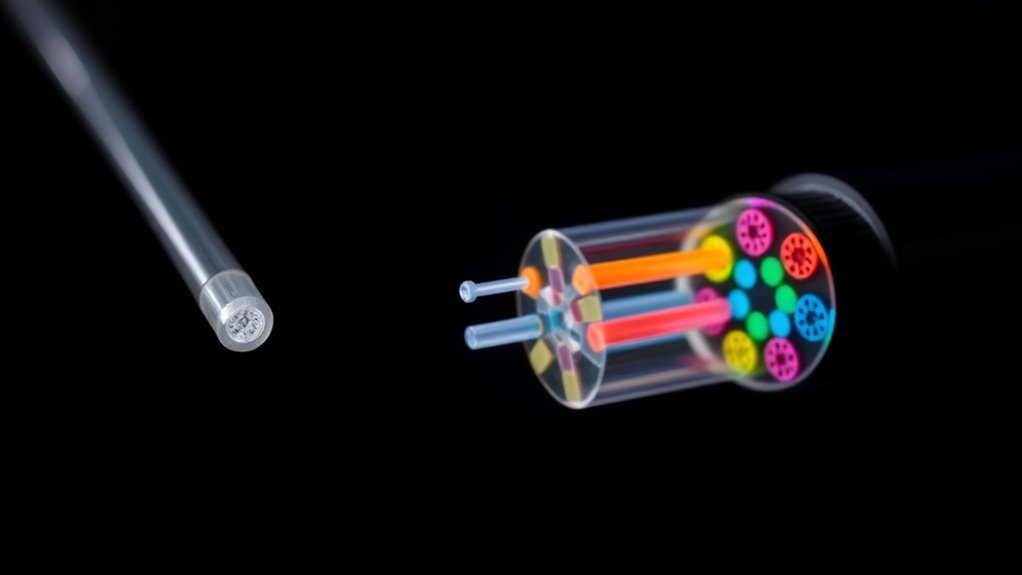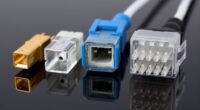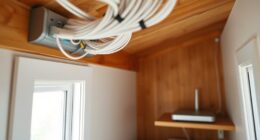Just like a master architect chooses the right materials for a building’s foundation, selecting between single-mode and multi-mode fiber impacts your network’s performance and future. While both serve the purpose of transmitting data, their differences in core size, distance, and cost can shape your entire setup. Understanding these distinctions is essential, but which type best fits your specific needs might surprise you—so let’s explore their key features and applications.
Key Takeaways
- Single-mode fiber has a small core (~8-10 microns) for long-distance, high-speed transmission, while multi-mode has a larger core (50-62.5 microns) suitable for shorter runs.
- Single-mode offers higher bandwidth and minimal signal loss over long distances; multi-mode is easier to install and ideal for local-area networks.
- Single-mode installation is more complex and costly, requiring precise splicing; multi-mode is simpler and more forgiving during setup.
- Single-mode is future-proof, supporting scalability and high-demand applications; multi-mode may need upgrades as network needs grow.
- Use single-mode for telecommunications and data centers; multi-mode is preferred for building and campus LANs.

When choosing fiber optic cables for your network, understanding the differences between single-mode and multi-mode fiber is crucial. These two types of fiber are designed for different applications, and selecting the right one can impact your network’s performance, cost, and long-term maintenance. Single-mode fiber uses a tiny core, usually around 8 to 10 microns, allowing only one light mode to pass through. This design enables data to travel over longer distances with minimal signal loss, making it ideal for telecommunications, data centers, or wide-area networks. Multi-mode fiber, on the other hand, has a larger core, typically 50 to 62.5 microns, which allows multiple light modes to propagate simultaneously. While this might seem advantageous, it results in modal dispersion that limits the distance over which signals can be transmitted effectively.
When you’re planning fiber installation, these differences influence your choices markedly. Single-mode fiber’s ability to carry signals over many kilometers at high speeds makes it suitable for backbone connections and long-distance links. However, installing single-mode fiber can be more complex and costly due to the precision required for splicing and connectorization. Maintenance challenges also differ; single-mode systems demand more careful handling and precise equipment calibration to guarantee maximum performance over time. Multi-mode fiber, with its easier installation and alignment processes, is often preferred for shorter runs within buildings or campus environments. Its larger core makes connectors and splicing less delicate, reducing initial setup costs and complexity. But, over time, multi-mode systems may face issues like modal dispersion, which can degrade signal quality if not properly managed.
Another factor to consider is that multi-mode fiber tends to be more forgiving during fiber installation, especially when handling bends or rougher environments. Still, its limitations in distance and bandwidth mean you’ll need to upgrade sooner if your network expands or demands increase. Conversely, single-mode fiber, while initially more expensive and requiring more precise installation techniques, offers scalability and future-proofing for high-speed, long-distance applications. Maintenance challenges for single-mode fiber include ensuring connectors stay clean and free of contaminants, as even tiny dirt particles can cause signal degradation. Both types demand regular inspection, but the stakes are higher with single-mode due to its sensitivity. Additionally, advancements in fiber technology continue to improve the performance and ease of maintenance for both types, making informed choices even more critical.
Frequently Asked Questions
How Do Installation Costs Compare Between Single-Mode and Multi-Mode Fibers?
You’ll find that installation expenses for single-mode fiber are generally higher due to increased installation complexity. Single-mode fibers require more precise splicing and specialized equipment, which can add to costs. Multi-mode fiber, on the other hand, usually has lower installation expenses because it’s easier to work with and less sensitive to alignment issues. Overall, your choice depends on balancing initial installation costs with long-term performance needs.
Which Fiber Type Offers Better Future Scalability Options?
Single-mode fiber offers better future-proofing options and scalability potential. It supports higher bandwidths and longer distances, making it ideal for expanding networks. With its ability to accommodate future upgrades and increasing data demands, single-mode fiber guarantees your infrastructure remains relevant longer. Choosing single-mode means investing in a solution that adapts to technological advancements, providing you with enhanced scalability options now and in the future.
Are There Environmental Factors That Favor One Fiber Type Over the Other?
Environmental factors do influence your choice between single-mode and multi-mode fiber. Single-mode fiber offers better environmental durability, especially in outdoor or harsh conditions, due to its smaller core and protective coatings. Multi-mode fibers are more susceptible to environmental damage and may require more maintenance. Cost implications also matter; single-mode fibers tend to be more expensive initially but may save money long-term in demanding environments, whereas multi-mode fibers are cost-effective for short-distance indoor setups.
How Do Maintenance Requirements Differ Between Single-Mode and Multi-Mode Fibers?
Think of fiber maintenance like tending a delicate garden. You’ll need to regularly clean connectors to prevent dirt from blocking signals, especially in multi-mode fibers where dirt can cause more issues. Splice protection is essential for both types, but single-mode fibers often require more precise handling due to their thinner cores. Consistent inspection and proper connector cleaning keep your network running smoothly, reducing downtime and costly repairs.
Can Multi-Mode Fibers Support the Same Distances as Single-Mode Fibers?
No, multi-mode fibers can’t support the same distances as single-mode fibers. Due to distance limitations and signal attenuation, multi-mode fibers are best for shorter runs, typically up to a few hundred meters. The larger core causes more modal dispersion, which limits their effective distance. If you’re aiming for longer distances with minimal signal loss, single-mode fibers are the better choice because they handle longer spans with less attenuation.
Conclusion
In the end, choosing between single-mode and multi-mode fiber depends on your needs. Single-mode is like a fine-tuned race car, offering high speed and long-distance capabilities, but it comes at a higher cost. Multi-mode, on the other hand, is more like a reliable family sedan—easier to install and perfect for shorter runs. Know your priorities, and you’ll have the right road paved for your network’s journey.









